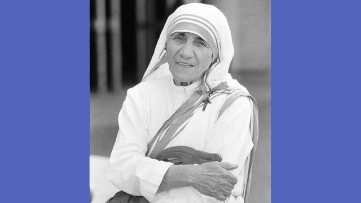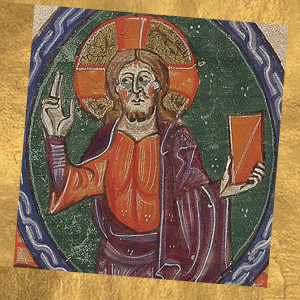S. Mother Theresa of Calcutta

“I present you the most powerful woman in the world.” It is October 26, 1985, when UN Secretary-General Pérez de Cuéllar introduces Mother Teresa of Calcutta to the United Nations General Assembly. Certainly, the little religious sister wrapped in her white sari with blue piping felt uncomfortable with that emphatic presentation, preferring to describe herself as a “pencil stub in God's hands”.
“Come, be my light”
Minute in body, giant in faith, Mother Teresa was born to an Albanian family in Skopje on August 26, 1910, and is given the name Agnes Gonxha. As a child, she is taught by her parents to live praising the Lord and helping the most needy. It is not surprising, therefore, that she should have chosen, at age 18, to become a missionary. Agnes left home in September, 1928, to enter the Institute of the Blessed Virgin Mary in Dublin, where he received the name of Mary Teresa. The following year she would be in India, where she lived happily for nearly 20 years in a school of her congregation, teaching the wealthy young people in the area. On September 10, 1946, however, Mother Teresa received what she calls her “calling within a calling”. That day, Jesus revealed to her His pain at seeing indifference and contempt for the poor, and asked Teresa to be the face of His mercy: “Come, be my light. I can not go alone.”
Missionaries of Charity
After her first experience of leaving home, 20 years later she left her Institute to found the Missionaries of Charity, taking the name Mother Teresa and wearing the Indian Sari, beginning her new mission among the last of Calcutta, the outcast, those who are “unwanted, unloved, uneducated”. Some of her former students would soon join her, and in the space of a few years, the Congregation - recognized in 1950 by the Archbishop of Calcutta and in 1965 by Bl. Paul VI - spread to every part of the world where the poor need help and especially love. The Missionaries of Charity open homes in Africa and Latin America, but also in the Communist countries and even in the Soviet Union. Her figure rapidly became more and more popular worldwide, but, when asked about the secret of her success, she would respond with disarming simplicity: “I pray.” Bl. Paul VI held her and her Sisters in high esteem, and gave them his Papal automobile at the end of his trip to India. Mother Teresa also had a deeply fraternal relationship with Pope St. John Paul II. Particularly memorable was Pope St. John Paul II’s visit to the house in Calcutta, where Mother Teresa welcomed the dying. It was also Pope St. John Paul II who desired that there be a structure in the Vatican, the “Gift of Mary”, for the Missionaries of Charity.
In defense of life
Always ready to help the poor and needy, Mother Teresa was also strongly committed to the defense of nascent life. Her speech at the Nobel Peace Prize ceremony on October 17, 1979 was unforgettable. “The greatest destroyer of peace,” she said on that occasion, “is the cry of the innocent unborn child.For if a mother can murder her own child in her womb, what is left for you and for me to kill each other?”. Even in later years, despite illness and the “dark night of the soul” she experienced, Mother Teresa never spared herself, and continued tirelessly to respond to the needs of the needy. She died on September 5, 1997, in Calcutta. At that time, there were 4 thousand of her Sisters in the world, present in 610 mission houses spread out in 123 countries. She remains for us the sign that mercy has no boundaries and comes to all, without distinction, because, as Mother Theresa said, “Maybe I do not speak their language, but I can smile.”







